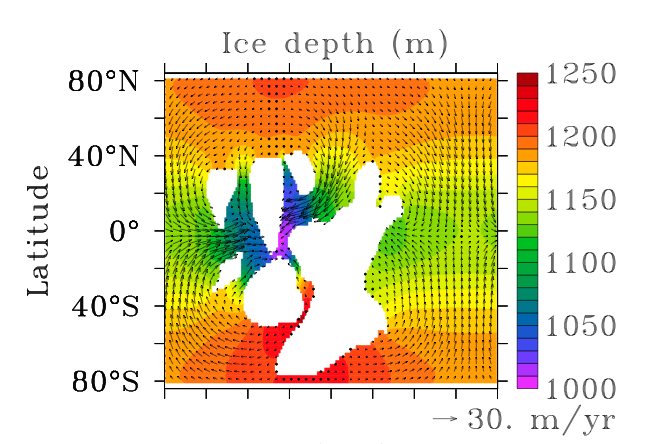story by Helen Hill

 Between ~750 and 635 million years ago, during the Neoproterozoic era, the earth experienced at least two significant, possibly global, glaciations, termed “Snowball Earth.”
Between ~750 and 635 million years ago, during the Neoproterozoic era, the earth experienced at least two significant, possibly global, glaciations, termed “Snowball Earth.”
While many studies have focused on the dynamics and the role of the atmosphere and ice flow over the ocean in these events, only a few have investigated the related ocean circulation associated with them, and, until recently, none has examined the ocean circulation under a thick (~1 km deep) sea ice cover, driven by geothermal heat flux.

Yossi has been using the MITgcm over the past 10 years, to study present and past ocean dynamics. When not busy at home and work he likes running, hiking and reading.
In their January 2014 JPO paper Ocean Circulation under Globally Glaciated Snowball Earth Conditions: Steady-State Solutions, Yosef Ashkenazy (Ben-Gurion University of the Negev), Hezi Gildor (Hebrew University of Jerusalem, Israel), Martin Losch (Alfred-Wegener-Institut, Germany), and Eli Tziperman (Harvard) report their work using a thick sea ice–flow model coupled to an MITgcm ocean to study Snowball Earth ocean circulation conditions.
Losch, a long time MITgcm developer is author of MITgcm’s ice-shelf package (Losch, 2008) the tool that allows incorporation of ice thicknesses spanning many vertical layers used in this study.
In experiments under a simplified zonal symmetry assumption, the team report observing strong equatorial zonal jets and a strong meridional overturning cell tightly limited to an area very close to the equator.
Through a suite of experiments, the team were able to derive an analytic approximation for the latitude–depth ocean dynamics from which they found that the extent of the meridional overturning circulation cell only depends on the horizontal eddy viscosity and β (the change of the Coriolis parameter with latitude).
Further, three-dimensional ocean simulations, with reconstructed Neoproterozoic continental configuration, confirmed the zonally symmetric dynamics, exhibiting additional boundary currents and strong upwelling and downwelling near the continents.
To find out more about this work contact Yossi. Related publications include:
Ashkenazy, Y., H. Gildor, M. Losch, F.A. Macdonald, D.P. Schrag and E. Tziperman (2013), Dynamics of a Snowball Earth ocean, Nature, Vol. 495, pp. 90-93, doi:10.1038/nature11894, Ashkenazy, Y., and E. Tziperman, Variability, instabilities and eddies in a Snowball ocean, J. Clim., (submitted)
This Month’s Featured Publication:
- Ashkenazy, Y., H. Gildor, M. Losch, and E. Tziperman (2014), Ocean Circulation Under Globally Glaciated Snowball Earth Conditions: Steady-State Solutions, J. Phys. Oceanogr., 44, 24–43, doi: 10.1175/JPO-D-13-086.1
Other New Publications this month:
Bachman, S.D., and J.R. Taylor (2014), Modelling of partially-resolved oceanic symmetric instability, in press for Ocean Modelling, available online August4, 2014, doi: 10.1016/j.ocemod.2014.07.006
Brüggemann Nils and Carsten Eden (2014), Evaluating Different Parameterizations for Mixed Layer Eddy Fluxes induced by Baroclinic Instability, Journal of Physical Oceanography, e-View, doi:10.1175/JPO-D-13-0235.1
Chuanyu Liu, Armin Köhl, and Detlef Stammer (2014), Interpreting layer thickness advection in terms of eddy–topography interaction, Ocean Modelling, Available online 28 July, 2014, doi: 10.1016/j.ocemod.2014.07.001
Djoumna, G., K.G. Lamb and Yerubandi R. Rao (2014), Sensitivity of the Parameterizations of Vertical Mixing and Radiative Heat Fluxes on the Seasonal Evolution of the Thermal Structure of Lake Erie, Online at Atmosphere and Ocean, doi: 10.1080/07055900.2014.939824
Matthew D. Thomas, Agatha M. De Boer, Helen L. Johnson, and David P. Stevens (2014), Spatial and Temporal Scales of Sverdrup Balance, Journal of Physical Oceanography; e-View, doi: 10.1175/JPO-D-13-0192.1
Munday, D.R., H.L. Johnson, and D.P. Marshall (2014), Impacts and effects of mesoscale ocean eddies on ocean carbon storage and atmospheric pCO2, in press for Global Biogeochemical Cycles, doi:10.1002/2014GB004836
Do you have news about research using MITgcm? We are looking for contributions to these pages. If you have an interesting MITgcm project (ocean, atmosphere, sea-ice, physics, biology or otherwise) that you want to tell people about, get in touch. To make a post, contact Helen.

